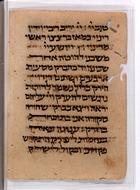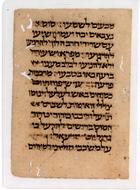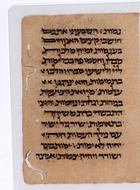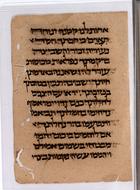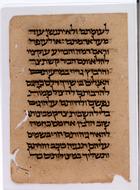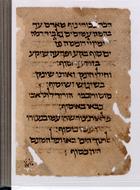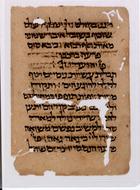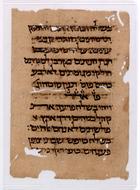Halper 252 Collected piyutim for the seventh day of Passover
Title
Collected piyutim for the seventh day of PassoverCall number
Halper 252(Philadelphia, United States, University of Pennsylvania, Center for Advanced Judaic Studies Library, Cairo Genizah Collection)
Alternate identifiers
Publisher
Center for Advanced Judaic Studies LibraryLanguage
HebrewOrigin
12th century-14th century?
- Place
-
Orient
Notes
- Four fascicles, the first three are complete, ten folios each, the last is missing its exterior bifolium; fascicles numbered in the upper corner of the first page, 3 [g], 4 [d], and 5 [h]; catchwords on versi of fascicles; verse endings denoted by a sof pasuḳ; Published by Davidson, Piyuṭim ṿe-shirim min ha-genizah shebe-Mitsrayim (Ginze Shekhṭer, vol. III). New York : JTS, 1928, pp. 48- 106, with a parallel text found in ms. Mosseri, IV 212 and Oxford Bodleian Heb. f. 57 (Cowely 2852). Additional ms. sources parallel to much of the material here, are listed by M. Zulay: Yediʾot ha-Makhon le-ḥeḳer ha-shirah ha-ʾIvrit, v. 5 (1929), p. 163; Most of the material in this fragment (fols. 6-37) is a matsdar on Song of Solomon attributed to Samuel ha-Shelishi. Some of the material is attributed to Joseph Albaradani and other authors; Titles: A. (fol. 1)את בני בכורי אנהגהו (missing the first 2 lines) . Republished from this, and parallel ms. sources, by Y. Yahalom, Piyuṭe Shimʹon bar Megas. Yerushalayim : ha-Aḳademyah ha-leʾumit ha-Yiśreʾelit le-madaʹim, v. 1 (1984), p. 274, as it may be attributed to bar Megas. Followed by its refrain מה תצעק בעד איומה; B. (fols. 1-2)[את בני בכורי ל[א אענה, and its refrain מה תצעק יקותיאל. The latter was published, along with parallel ms. sources, by T. Beeri, Matsdarim and Yotserot of Joseph al-Baradani (Doctoral dissertation), Jerusalem, 1990 p. 409. This and the previous appear in no. 253(T) in a different arrangement; C. (fol. 2). אמצו ויחזק לבבכם. The theme, scriptural verses that serve as the refrains, here and in the next four titles, are from Ex. XIV; D. (fols. 2-3) (אאמירם לי לאיומה (א-ת, and its refrain התיצבו וראו את ישועת אלהי עולם. Both also appear in no. 253(W); E. (fols. 3-4) Verses א-ד of אמנם בעבור יצעקו. Listed by M. Zulay, Yediot ha-makhon le-ḥeḳer ha-shirah ha-ʹIvrit, v. 2 (1936), p. 287, 367) as an element from a Ḳerovah of Yannai for the Erez-Israeli seder of Ex. XIV republished as such in Piyuṭe Yanai / Menahem Zulay [ed.]. Berlin : Shocken, 1938, p. 97-98 no. 43 (index p. 430), and again by M. Rabinowitz, Maḥazor piyuṭe Rabi Yanai la-Torah ṿela-moʹadim / Zvi Meir Rabinowitz [ed.]. Jerusalem : Mossad Bialik, 1985, vo1. 1, p. 308-309. Followed by its refrain הים מפניהם והאויב מאחריהם. Both are also found in no. 253(X); F. (fols. 4-5) ʾt lbb ʻmy mh tšbr. This and the following piyyut were published from this, and parallel ms. sources, by Y. Yahalom, Piyuṭe Shimoʹon bar Megas. Yerushalayim : ha-Aḳademyah ha-leʾumit ha-Yiśreʾelit le-madaʹim, 1984, p. 198-200, where they appear as elements in a piyyut for the reading of Ex. XIV 15, attributed to bar Megas. Also found in no. 253(Y); G.אמצו נמהרים, four, two-verse strophes (ordered א-ח), and its פזמון which starts אל בים סוס כרמה; H. (fols. 6-37) Under the headline שיר השירים, a Matsdar on Song of Solomon, that begins שיר השירים אסלסל, attributed to Samuel ha-Shelishi; I. (fol. 37) יודע ועד וסומך. The acrostic reads יוסף חזק. This starts a series of piyyutim from a Ḳedushta for the reading of ויושע, which continues through the end of the fragment. Published by S. Bernstein, Tarbits v. 13 (1942), p. 154; Beeri, Matsdarim, p. 406; Beeri, ha-Ḥazan, 2003, p.452; J. (fol. 38) Under the heading פזמ[ון], לחן ספורו, לרבינו סהלאן ז"ל ימצא רחמים, possibly referring to Sahlan b. Abraham, סעדתי יהב משליך. The acrostic reads סהלאן; K. (fols. 38-39) כסיסירא בקישון. The acrostic of the verses is alphabetical (א-נ), the acrostic of every third verse reads שלמה יזכ; L. (fols. 39-40) מוליך לימין משה. Followed by its פזמון, of which the acrostic reads יוסף אלברדאני. Starts ים סוף בקע ופרעה שקע. Republished by Bernstein ibid. p. 154; Beeri, Matsdarim, p. 408; ; Beeri, ha-Ḥazan, 2003, p.452. The last 7 verses are in the missing folio; M. (fols. 40-43) a Kiklar for the reading of ויושע. Starts איכר וצימדו כהורהו. The biblical verses that serve as refrains are from Ex. XV. The acrostic reads א-ת יוסף. The first six strophes are in the missing folio. M. Zulay (Yediot ha-makhon, v. 5 (1929), p. 160-161) found an additional acrostic: ywmh byrby nymn , and thus attributes this to Joseph b. Nissan, of the classical era; N. (fols. 43-44). Under the heading ובכן ויושע י'י ביום ההוא, eight strophes, each beginning with consecutive phrases from Ex. XIV 30. Starts ויושע י'י אתו נושעים; O. (fols. 44-47) Under the heading ובכן ויהי בשלח פרעה, eleven strophes ordered א-ת, each begins with the word בשלח. Starts תנין סוטה בכל עת חוטא; P. (fols. 47-48) Starts אמונת ראשונים משולי גבנונים and its refrain עיניהם נשאו והנה צרים באו. Both are found in no. 253(V) where the last two verses are missing; Q. (fol. 48) קיהלו גדודים ואיחדו רכבם. The melody suggested is הנה מטתו, followed by its פזמון, where the melody suggested is אותות. Starts נשאו עינם חוכי לעונם; R. The heading ובכן ויושע י'י ביום ההוא.
- Condition: exterior bifolium lacking from last fasc.
Extent
13.7 X 9.8 cmSupport
PaperLayout
Decoration
Material applied: black ink
Script
Provenance
- Cairo Genizah Collection (University of Pennsylvania. Center for Advanced Judaic Studies. Library).
- Cairo Genizah Collection (Dropsie College. Library).
- Adler.
Subjects topical
- Piyutim
Licenses
-
- Text
- These images and the content of Center for Advanced Judaic Studies Library, Halper 252: Collected piyutim for the seventh day of Passover are free of known copyright restrictions and in the public domain. See the Creative Commons Public Domain Mark page for usage details, http://creativecommons.org/publicdomain/mark/1.0/.
- URL
- http://creativecommons.org/publicdomain/mark/1.0/
-
- Text
- Metadata is ©2017 University of Pennsylvania Books & Manuscripts and licensed under a Creative Commons Attribution License version 4.0 (CC-BY-4.0 https://creativecommons.org/licenses/by/4.0/legalcode. For a description of the terms of use see the Creative Commons Deed https://creativecommons.org/licenses/by/4.0/.
- URL
- https://creativecommons.org/licenses/by/4.0/legalcode














